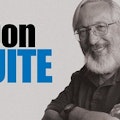I talking to my fellow editors, I proposed that “orthogonality” means non-derivative thinking. For example, at the end of his article, Grove seemed to be in favor of protective tariffs, which are orthogonal to my thinking—very Herbert Hoover/Smoot-Hawley. But that’s my only point of disagreement. I like everything else Grove said in his article.
In particular, I liked where Grove recalled Intel giving away its soon to be cyclical commodity memory business lock, stock, and barrel to the Japanese in the 1970s, betting the farm, especially the acreage in Oregon, on microprocessors. Talk about orthogonal! Talk about prescience! Who among us could have conceived where the 8008 would take us? Even later, when embedded control was better understood, how many of us conceived of a need to embed anything more powerful or compact than an 8051 in a dual-inline package?
Timing And Luck
Abandoning memory for the microprocessor was brilliant and truly orthogonal thinking at the time, but conceptual orthogonality is ephemeral. It’s a tide, as Shakespeare says, best “taken at the flood.”1 Indeed, timing is everything, as are business practices. A decade later, Charlie Sporck’s jettisoning of National Semiconductor’s analog business in favor of the Clipper did not produce similar results.2 And as Motorola demonstrated, even getting into the market early with an orthogonal product doesn’t guarantee endless success. (68000 anyone? Power Processor?)
Venture Funding, The Foe Of Orthogonality
One problem is where you go to get the money to launch an orthogonal product if you don’t have deep pockets yourself. It used to be easier. As Charlie Trimble once explained it to me, Hewlett-Packard let him execute a leveraged buyout (LBO) to acquire the lab and staff he’d been working with when HP decided that GPS was too orthogonal for them.
An LBO is different than selling yourself to a venture capitalist (VC). Unfortunately, LBOs aren’t as likely to happen today as they were in the early 1980s when Trimble Navigation was founded. My impression is that in today’s climate, few VCs are willing to take real risks, so they tend to fund copycat new ventures. And that’s prudent of them. I’ve worked for several failures that failed simply because they were 10 or 20 years ahead of the market.3
Hunting Down Orthogonality
Not that orthogonality is absent today. It’s just not in the entrepreneurial mainstream. The best example of orthogonality that I came across recently was in a proposal from Keith Lofstrrom, a top-notch analog chip designer and old friend from my Tektronix days. It’s called “Server Sky”. Lofstrrom came down to the Valley last December to pitch the idea to an audience at TechShop. There was a number of NASA-Ames people in the audience and they took what he said seriously, even though it is definitely leading-edge.
Contiue to next page
Essentially, Server Sky is a plan for a supercomputer comprising a large array of wafer-scale servers, in space, that dynamically maintain their position in the array by acting as solar sails. That is, they autonomously change the reflectivity of elements on the wafer, enabling the use of solar wind for propulsion. The point of controlling all the server wafers’ relative position is to create a massive, broadband, phased-array antenna system for communication with the planet. (The objective is to sell time on the system for computationally intensive applications such as weather modeling.)
How do the wafers get up there in the first place? Well, if I understood it right, the plan involves a somewhat horizontalized version of Minsky, McCarthy, and Moravec’s Space Fountain, based on a very big rail gun. (It’s all detailed, including the criticisms. Follow that Server-Sky link to read it all.) By the way, Lofstrrom was talking up the idea down here in the Valley to find fellow spirits who would pursue the idea with him.
A Little Less Orthogonality
If you find Server Sky orthogonal to too many axes, consider TechShop, the venue for Lofstrrom’s talk. It’s a machine-shop co-op for hard-core geeks created by Jim Newton. The mothership where Lofstrrom spoke is off 101 in Menlo Park, Calif. There’s another in Durham, N.C., one in Portland, Ore., which is moving to larger quarters, and two more in the Bay Area (San Francisco and San Jose) that will open soon.
That’s a few degrees of freedom less orthogonal than Server Sky, but the main axis to which TechShop is orthogonal to is the venture-capital axis. For $125 a month, members get access to half a million dollars of new shop equipment. Even with some rocky starts that reflect today’s unemployment, the first tech shop is in fact spawning clones in places where new technology is incubated.
Now if we could just get rid of financial reporting rules that emphasize quarterly results over all other indices of corporate success and restore tax advantages for real long-term R&D, we might see some truly orthogonal results.
Notes
1. Better yet, at the start of the ebb, if you plan on leaving port.
2. There’s lots more than that to the National story. It’s nice to see them recapturing some of that analog mojo now.
3. And Charlie Trimble had a stroke of luck when his civilian handhelds came out just in time for Desert Storm and parents and spouses rushed to buy them for troops in Kuwait and Iraq.
About the Author

Don Tuite
Don Tuite (retired) writes about Analog and Power issues for Electronic Design’s magazine and website. He has a BSEE and an M.S in Technical Communication, and has worked for companies in aerospace, broadcasting, test equipment, semiconductors, publishing, and media relations, focusing on developing insights that link technology, business, and communications. Don is also a ham radio operator (NR7X), private pilot, and motorcycle rider, and he’s not half bad on the 5-string banjo.
